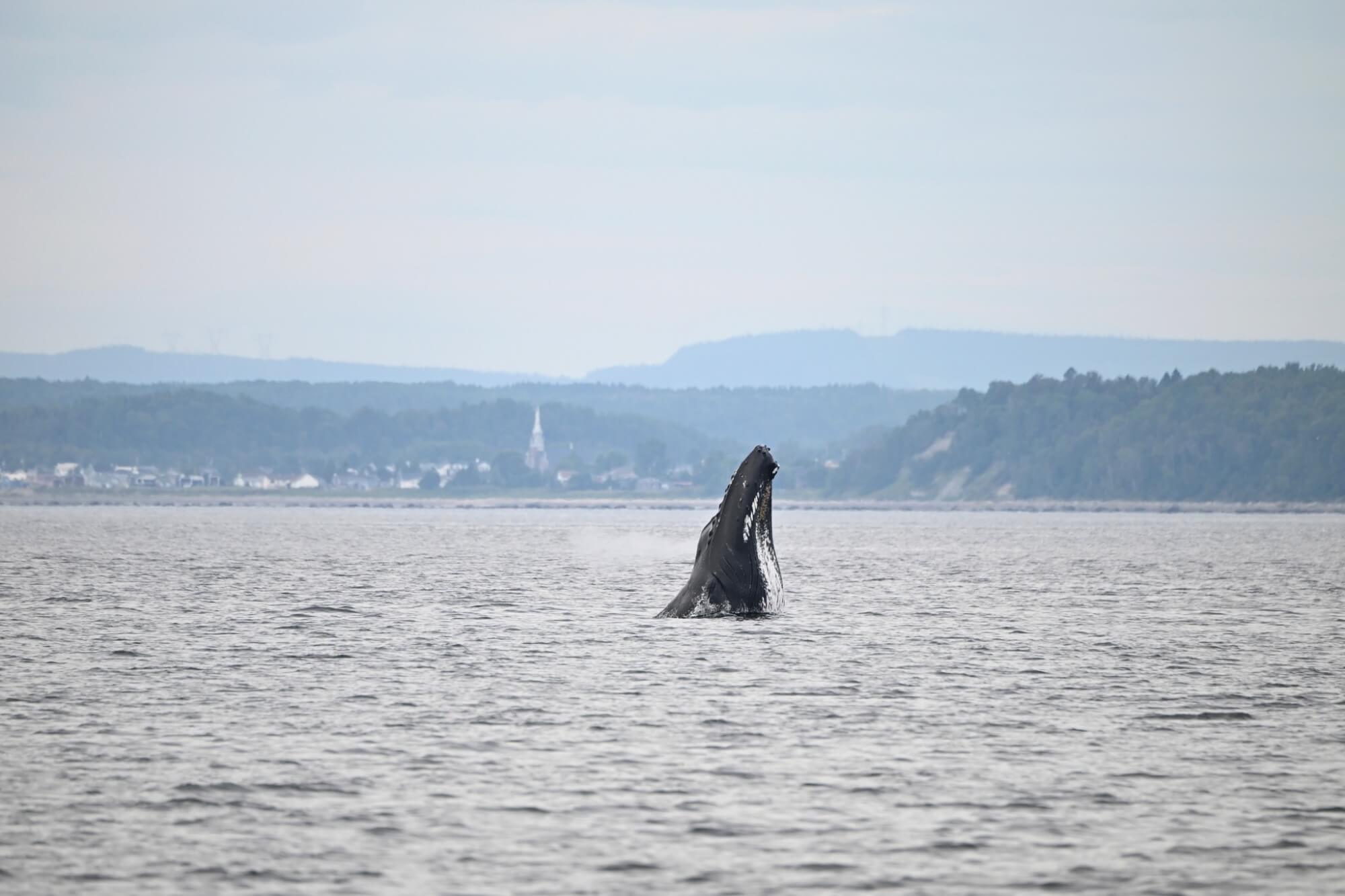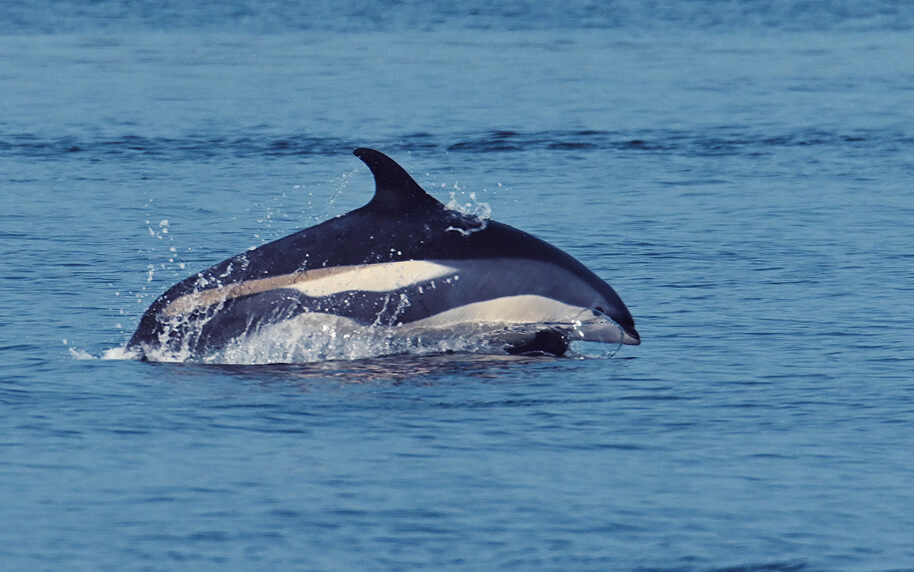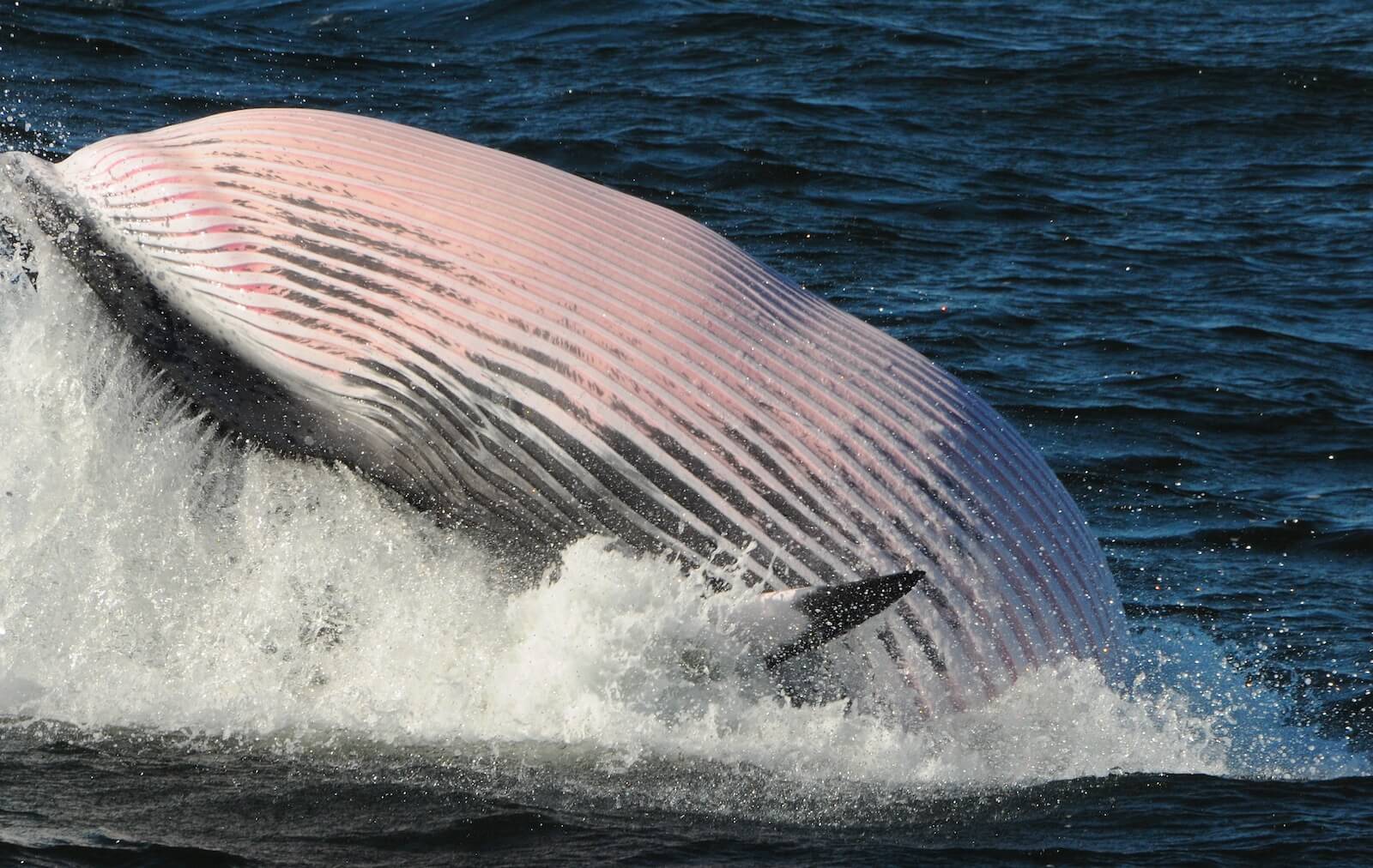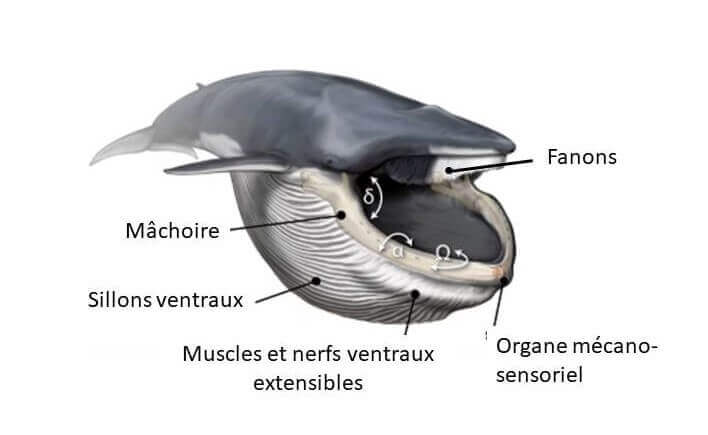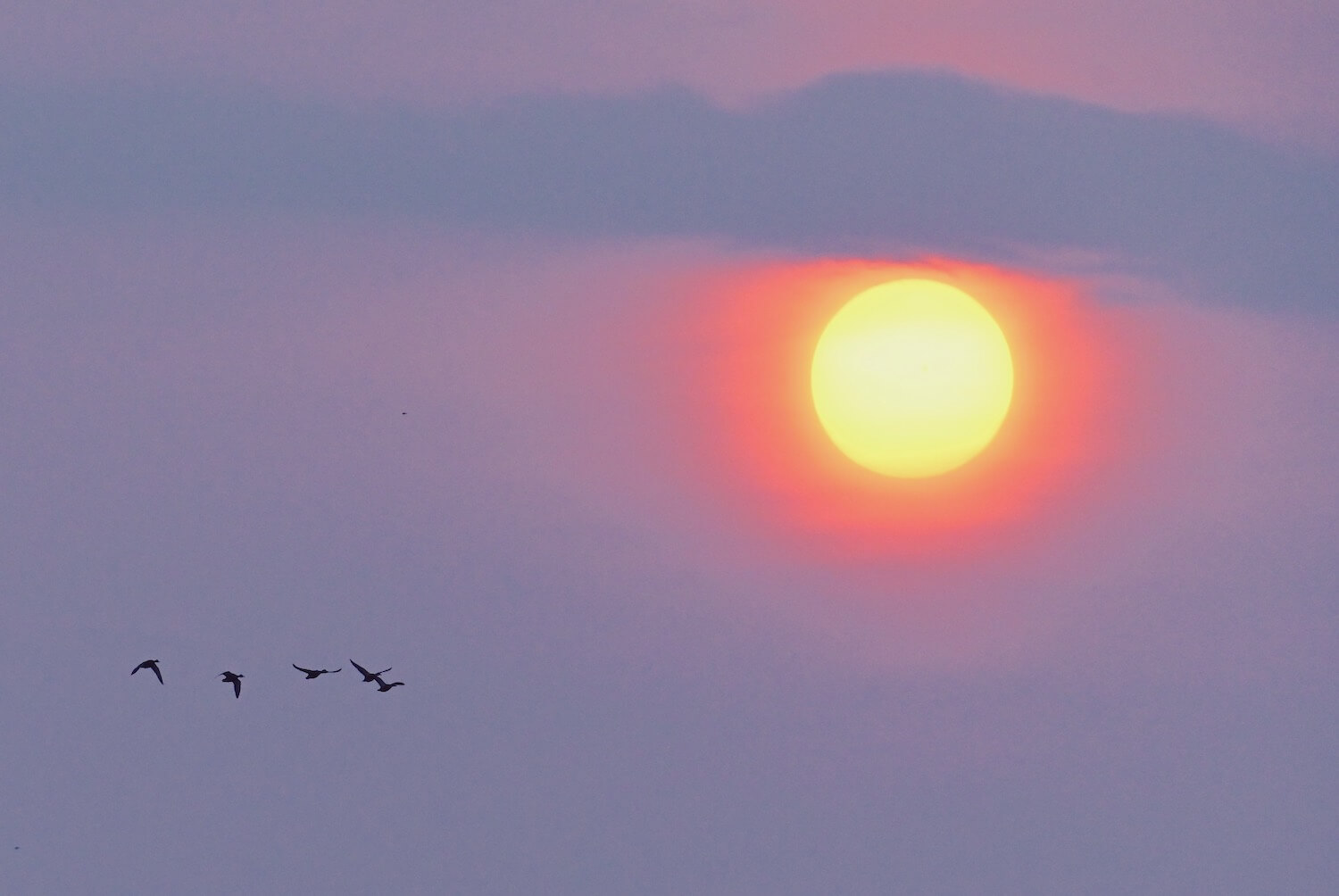Whether it’s groups of white-sided dolphins breaking the surface in successive bursts, minke whales showing their bellies, or the humpback whale Siam erupting out of the water, marine mammals have been everywhere in the waters of the St. Lawrence and they haven’t been holding back from performing their manoeuvres, each one more impressive than the last!
Dolphins, bluefin tuna and ocean sunfish
With their tones of blue, black, grey, white and yellow streaking across the water, dolphins never go unnoticed. One cetacean enthusiast in Gaspé Bay was left amazed. “We also saw quite a spectacle with a shower of gannets, interspersed with a group of about forty white-sided dolphins feeding in a school of fish. Between their synchronized jumps and backflips, they were leaping in every direction, putting on a one-of-a-kind show.” Although the species generally lives in groups of 3 to about 50 or so individuals, they are sometimes found in huge herds numbering in the hundreds or even thousands.
Other marine fauna representatives include minke whales, harbour porpoises and a humpback whale. “Also, bluefin tuna are now present in numbers, leaping completely out of the water,” describes a naturalist. “And we have also observed two ocean sunfish for the past three days, their fins slicing across the water surface. One of them measures at least a metre in diameter, the other one is smaller.” And yes, at Whales Online, we also report fish sightings!
From Baie-des-Sables, local residents reported the presence of five belugas swimming offshore as well as a few minke whales.
Minke whale bellies
“There were two minke whales at the pilots’ wharf feeding and doing surface manoeuvres; it was really impressive!” Posted in Les Escoumins for an observation session, the marine mammal enthusiast saw all sorts of things. “It was constantly alternating between black backs and white (and pink) bellies, so much so that people not far from us – who were likely witnessing this for the first time – thought that it was a completely different species of cetacean when the minke whale showed its belly.” A minke whale was feeding near the Marine Mammal Interpretation Centre in Tadoussac, much to the delight of passers-by. “A lot of people were also wondering about the white and pink they were seeing,” said one naturalist.” Similarly, the Baie-Comeau marina was flooded with minke whales manoeuvring on the surface. In the Mingan Island sector, a mariner also saw a minke whale and its belly, not to mention porpoises and grey seals.
To take big bites, minke whales have a number of morphological adaptations, including baleen plates, a non-fused jaw, grooves, muscles and highly elastic ventral nerves. When surface feeding, minke whales engulf a huge quantity of water that stretches their ventral grooves. With the differences in colour and their unique behaviour, it’s no wonder some people get confused!
A whaler’s morning wake-up call
There are mornings that we remember for a long time, especially when they involve cetaceans. “Early one morning in Les Escoumins while I was trying to make my coffee, the sound of a blowing whale masked the buzz of the mosquitoes and distracted me from what I was doing; an eastbound humpback was quietly swimming by. A second one turned around in the course of its breathing sequence. I was able to observe each of them twice, and they were just as half asleep as I was!” The joy of whale watching is an entirely different sort of caffeine!
In the Saguenay-St. Lawrence Marine Park, there’s action on the water with no fewer than five humpbacks identified in the past week and a fin whale, not to mention harbour porpoises and numerous seals.
“Still the famous trio of porpoises, minke whales and grey seals between Baie-Comeau and Franquelin,” shares one resident. Also, common terns have been well established for over a week now!”
Forest fire and whales
Winds have blown the smoke from the forest fires raging in the western parts of the country toward our shores.But as the saying goes, every cloud has a silver lining, as the colours of the Sun and Moon made for beautiful scenery! But could the deterioration in air quality have an impact on whales, which breathe at the water’s surface?
According to scientists, although little research is available, this unusual amount of smoke likely has little effect on whales. Whales have a respiratory system similar to our own in that they breathe consciously and pass air from their blowhole, the equivalent of our nose, to their lungs. When they come to the water surface, they replenish about 90% of the air in their lungs, compared to just 10 to 15% in the case of humans. Consulted in 2023 when forest fires were burning across Quebec, wildlife veterinarian Stéphane Lair had mentioned that the concentrations of smoke emitted by the fires would not be high enough to have an impact on whales.
Blue whales in Sept-Îles
“Four blue whales, two humpbacks, three minke whales, hundreds of porpoises and diving gannets…” The team at the Sept-Îles Education and Research Centre (CERSI) has had its hands full with all these observations! At one point, a porpoise and a gannet were even trying to eat the same fish. The presence of several fin whales as well as two basking sharks has also been reported.
Where are the whales this week? Observation map
These data were reported by our network of observers. They give an idea of the presence of whales and in no way represent the actual distribution of whales in the St. Lawrence. Just for fun!
Click on the whale or seal icons to discover the species, the number of individuals, additional information or photos of the sighting. To enlarge the map, click on the icon in the top right-hand corner. The map works well on Chrome and Firefox, but not so well on Safari.
To display the list of sightings, click on the icon in the top left-hand corner.
Thanks to all our collaborators!
Special thanks go out to all our observers who share their love for marine mammals with us! Your encounters with cetaceans and pinnipeds are always a pleasure to read and discover.
On the water or from shore, it is your eyes that give life to this column.
Odélie Brouillette
Marie-Andrée Charleboix
Raymonde et Marcel Cousineau
Guylaine Côté
Thalia Cohen-Bacry
Laetitia Desbordes
Pierre-Soleil Dion
Félix Fontaine
Jade-Audrey Lavergne
Yael Medav
Élizabeth Melis
Diane Ostiguy
Chloé Pazart
Renaud Pintiaux
Pascal Pitre
Guillaume Savard
Christine Stadelmann
Andréanne Sylvain
Marielle Vanasse
Additionally, we would like to acknowledge the following teams that also share their sightings:
Sept-Îles Research and Education Centre (CERSI)
Group for Research and Education on Marine Mammals (GREMM)
Marine Mammal Observation Network (MMON)
Quebec Marine Mammal Emergency Response Network (QMMERN)
Mingan Island Cetacean Study (MICS)
Would you also like to share your observations?
Have you seen any marine mammals in the St. Lawrence? Whether it’s a spout offshore or just a couple of seals, drop us a line and send your photos to [email protected]!


